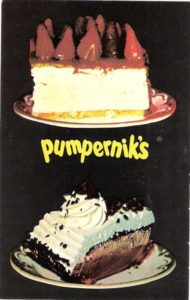As noted previously, the food and beverage business’ history in this area actually goes back to pre-1900, and in our first two installments (Read Part I and Part II) we brought the story up to the late 1920’s. Although the Great Depression occurred in 1929, and “the five terrible events” which occurred in Miami in 1926 were the harbinger of the crash of the stock market in October 1929, historians are finally beginning to realize that “the five terrible events” which began the decline in business in South Florida in late 1926 were definitely the forerunner of the cataclysmic series of occurrences which brought about the Great Depression.
The culminating event of the aforementioned five was the horrific September 17-18, 1926 hurricane. “So what then,” you insightfully ask, “is the relationship of that unnamed cyclonic event to the food and beverage business in Greater Miami (and, by extension, in South Florida) at the time?” And the answer is quite simple: during that period, there were thousands and thousands of either visitors or newcomers here from various parts of the country, and not only did few of them know what a hurricane was or understand it’s capacity for utter destruction, but the death toll of close to 600 and the horrific damage it caused brutalized every part of Greater Miami, not the least of which was the restaurant, bar and club business.
Interestingly enough, though, it is important that we note that while the recovery from the five terrible events went on for several years, Florida suffered less than any other state during the depression. The reasons are quite simple: the Sunshine State had little to no manufacturing, but did have an immense amount of acreage devoted to farming and cattle, along with almost unlimited resources coming from the water, and people, even during that economic debacle, still needed to eat. Along with feeding huge numbers of people, there was still a desire, among those with money (and, yes, even in the depression, a good few still had enough disposable income) to allow them to vacation in the place where summer spent the winter.
Into the 1930s, Greater Miami suffered less than almost any other place in the country, with, among other positives, art deco hotels being built on Miami Beach and bars, lounges, night clubs, coffee shops, snack bars and full service restaurants opening throughout most of the area. For a “small town,” Miami Shores didn’t do badly and beginning in the very late ’30s and well into the 1940s and ’50s, numerous places to enjoy everything from a hamburger to a full meal opened.
Although almost hard to believe today, Miami Shores, at one time, had four drug stores on Northeast Second Avenue, each of them with a “lunch counter,” which served from breakfast through dinner (usually till 8:00 PM) with two of them on opposite corners of Northeast Second Avenue and 96th Street. Later on, the Biscayne Cafeteria, at 9900 Northeast Second Avenue would draw people from all over Northeast (then) Dade County where African-American men, in crisp white uniforms, would greet diners at the end of the tray line and bring the trays (and the guests) to their tables.
Interestingly enough, two venues rarely thought of as eating places were quite busy through the years: Barry College for Women welcomed diners from the surrounding areas all during the school year while Biscayne Kennel Club had both snack bars and a very decent restaurant. (Barry today is, of course, Barry University, nationally known in many fields, both academic and athletics-related).
One of the most-frequented dineries was none other than “HoJo’s,” and for many years the Howard Johnson’s, with its “28 flavors” of ice cream and serving from early morning till late at night, was busy throughout the day and evening, the chain’s Miami Shores store on the southwest corner of Northeast Second Avenue and 95th Street.
If Shores-ites and the folks from the area wanted great fried chicken, Joe Hart, later of Castaways fame, opened his only not-on-Miami Beach branch of the fabled Pickin’ Chicken,” restaurant with its famed honey and biscuits, right on the site of today’s 90th Street Miami Shores Publix parking lot, while just south of there, where today’s Tropical Chevrolet is, was an open-roofed night club and restaurant.
Of course, and while the Shores was and is surrounded by other municipalities, we have only a limited amount of space, but we will go on to North Miami for our next issue, but, first, a quick stop for a Castle-burger, at Royal Castle, along with their marvelous birch beer and the best honey bun ever to be put forth by an American bakery, your choice of either Northeast Second Avenue or Northwest Seventh Avenue and 125th Street! They’re all gone now, but we will certainly keep the memories going, so join us next issue for more Lost Restaurants of Greater Miami.

Even though not within Miami Shores village limits, so many Shores people (and thousands of others) loved going to Pumpernik’s at the north end of the shopping center on the east side of Biscayne Boulevard and 125th Street.
(And who can forget the cherry cheesecake or the out of this world chocolate cream pie?!!)
Photo courtesy The Bramson Archive